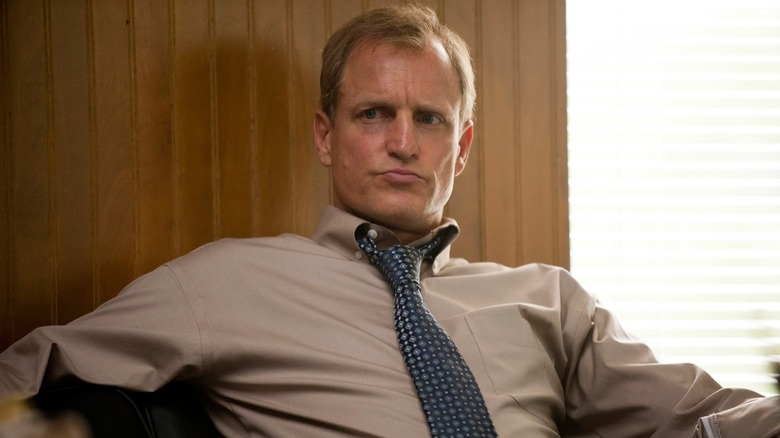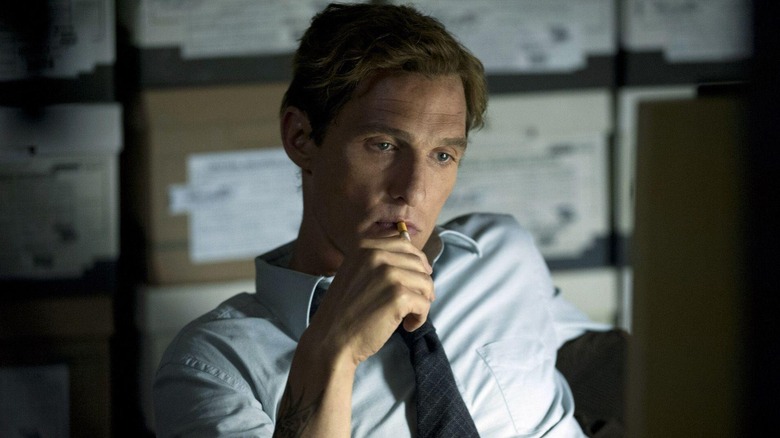True Detective Was A Novel And A Stage Play Before It Was A TV Show
When people talk about "True Detective" season 1, they naturally tend to focus on its broody atmosphere and memorable quotes ("Time is a flat circle;" "Once there was only dark. If you ask me, the light is winning"). As such, it's easy to forget just how funny the first season is thanks to the oil-and-water dynamic between Matthew McConaughey's relentless gloomy Rustin "Rust" Cohle and his everyman fellow state homicide detective Martin "Marty" Hart (Woody Harrelson). Just the dismayed expressions on Marty's face every time Rust goes off on another one of his bleak philosophical diatribes are pure comedic gold.
We're lucky, then, that "True Detective" creator Nic Pizzolatto ultimately decided against telling Rust and Marty's story in a written medium rather than a visual one. During a panel at the Austin Film Festival attended by /Film's Ryan Scott, Pizzolatto recalled that he came up with the idea for his acclaimed crime drama back when he was a novelist and short story writer, prior to getting his start as a TV scribe on "The Killing." He explained:
"I was still a novelist at the point I came up with ['True Detective'], and I was interested in plays and theaters. But I had originally planned another noir book that was going to be told from two points of view and alternating channels. So the one chapter would be Rust talking, then one chapter would be Marty talking."
You can see his logic. Rust and Marty have strikingly different personalities and worldviews, so much so it could be interesting to switch back and forth between their dual perspectives as narrators. (In a way, it reminds me a little of "Good Omens," where certain sections are told in Neil Gaiman's darker, more melancholic style while others unfold in Terry Pratchett's comparatively whimsical manner.)
'You know what this might be best for is a TV show'
"True Detective" season 1 is proof positive that sometimes all you really need to tell a compelling story is to hire two engaging actors to play off one another. For all of its memorable dialogue and technical flair, it's the interplay between McConaughey and Harrelson's gumshoes that really made the show sing in its freshman outing. In point of fact, when Pizzolatto realized his material might work better delivered aloud by a pair of actors, he considered making "True Detective" a stage play before settling on a TV series. In his own words:
"And then I was like, 'Well, this might be better as a two-man play, these two guys can share the stage.' And then I thought, 'You know what this might be best for is a TV show.' The more I started thinking about that, when it came time to create scripts for those agents, I turned what I had into the pilot for 'True Detective.' Again, nothing changed. I can look at those old moleskins and there's lines I wrote in 2010 that were in Matthew's mouth four years later."
While television has historically been thought of as a medium driven by writers and actors, it has always lent itself to visual experimentation (one need only watch the original "Twilight Zone" to grasp my meaning). Still, there's definitely been a shift in the way artists think about television and its potential for visual storytelling since Pizzolatto's crime series came along, and mostly for the better. It's another reason to be grateful that Pizzolatto decided TV was the way to go with Marty and Rust's misadventures, giving us a bevy of priceless Woody Harrelson reaction shots along the way.

